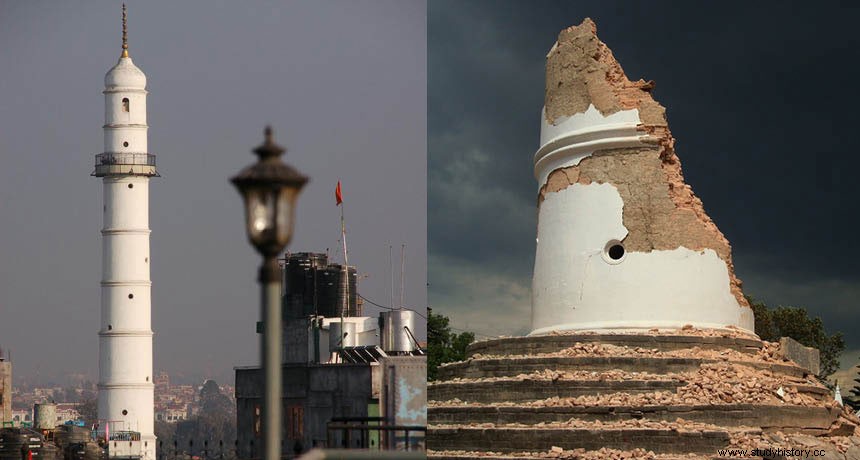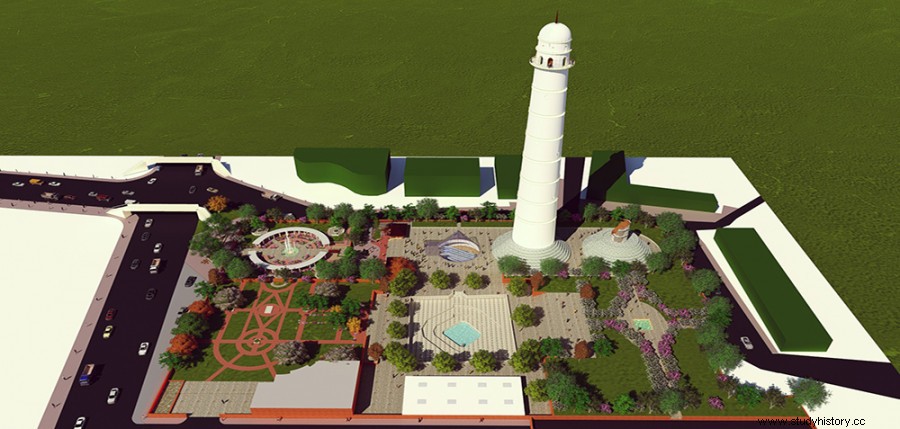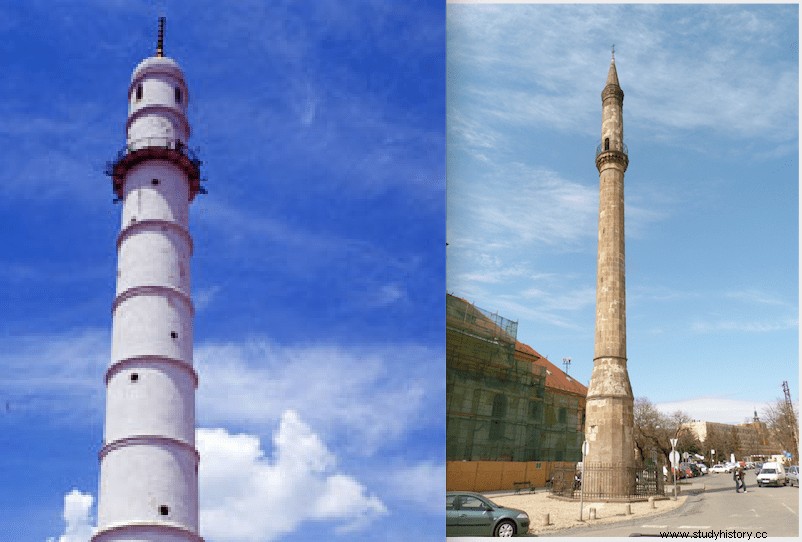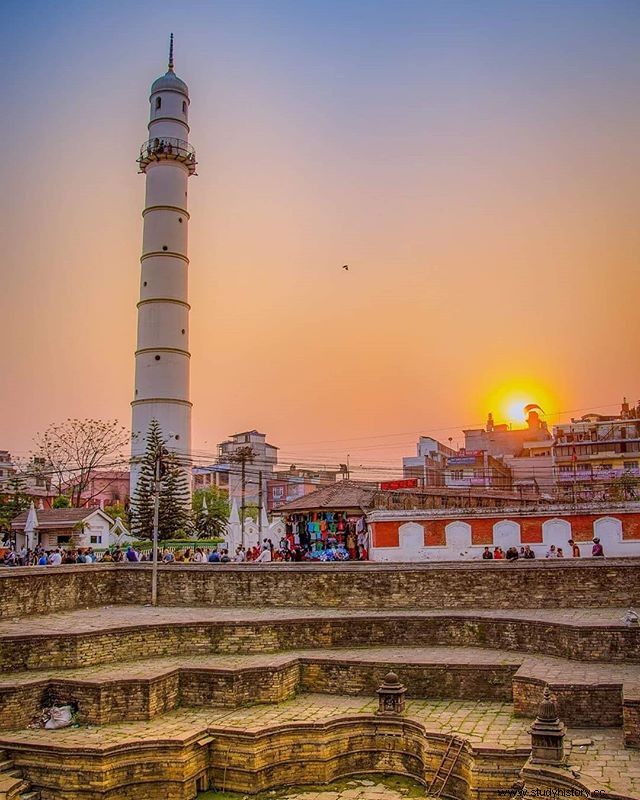Nepal is an ancient country. In this ancient land, there are many different buildings erected for religious and cultural purposes. One such building is the Dharara Tower. Over the years, it has undergone many changes, but its significance for the people of the country remains. It is considered a sacred building and has undergone many changes over the years. So, what exactly is the Dharahara Tower then?
What is the Dharahara Tower?

The Dharahara Tower was built in 1832 and is an impressive 203 foot tower. It was the pride and joy of many Nepalese in Kathmandu, Nepal. The tower was the tallest building in all of Nepal and was originally built for Queen Lalit Tripura Sundari. Over the years, it became useful as a watchtower for military use. Later it became a popular tourist destination when shopping malls and other such buildings appeared around the place. Inside the tower, there are over 200 steps on a spiral staircase with no exit before you reach the very top.
In the lookout tower, which is located on the eighth floor, there is an exit where you can look out on the busy streets below. From there, one can see the busy streets of Kathmandu to thousands of people taking care of their business. There are shops of all kinds, from the sale of clothes to food. You can also find buildings where people run offices. Best of all, there are also seats and a garden area around the Dharahara tower where others sit to relax and enjoy the beauty around them.
There is also a bronze mast at the very top of the building. The design and style of the building is similar to European and Mughal architecture. The original tower was inspired by a largely Mugal design and a Nepalese Gothic style.
Earthquakes lead to destruction
Nepal lies on a large plate called the Indian plate. This causes many earthquakes every few years, and while most are tame, some have been extremely devastating. Earthquakes are a common thing in Nepal, and it is easy to ignore the small earthquakes that reach 3.5 on the Richter scale (Latiff). There have also been cases where there have been major earthquakes that have caused major damage to the Dharaha Tower.
Earthquake in 1834
Two years after the tower was completed, Nepal was hit by an earthquake measuring 7.6-7.9 on the Richter scale. The main point of this earthquake was near the Kathmandu Valley. This led to around 500 people dying. The tower was smashed in two during this disaster. It was not rebuilt, but the following year a second tower was built to replace the original Dharahara tower.
Earthquake in 1934
Nearly a century later, another major earthquake shook the country. This caused the first tower to completely overturn. It also caused two of the nine floors of the second tower to collapse. This time there was an earthquake with a magnitude of 8.0. The death toll was up to 10,700 to 12,000 in total. Another difference from the first incident was that the new king made the decision to rebuild the tower immediately.
Earthquake in 2015

In 2015, an earthquake with a magnitude of 7.8 struck and turned the building into rubble. All that was left was the bottom of the tower. It is still remembered as a tragic event to this day. Many people come to visit the place years after the chaos and destruction that took place that day, as well as the 6 human lives that were lost in that building. In total, the earthquake in Nepal in 2015 killed around 200 people, and many others were injured. The government of Nepal made no decision to rebuild the tower until 2016. This time, they decided to turn the structure itself, from the base, into earthquake resistance. The building did not start until December 2018 and was not open until April 2021.
New Dharahara Tower

While the new tower was built motivated by the two originals, it does not use the new material from the other tower. It is a separate tower. The new tower is built next to the original tower. This new Dharahara is 236 feet high and 22 stories high. It copies the design to the original, with a bronze top. It is now in the center of a new museum, a garden and a fountain. Unfortunately, it is not open to visitors until November 2021.
The military use of the Dharahara Tower

The Dharahara Tower was originally built for military use. It was a way to assimilate all the military in the square. From the top of the tower, bugs were playing from the viewing platform. The lookout tower was also useful as a lookout for any incoming enemies, as it was high enough for soldiers to look far into the Kathmandu Valley. The tower was useful for making important announcements to a large group of people. Many can gather in the square below and listen to the conversations. It was a way to show the importance of the harmony between the different religions that are popular in Nepal. The most important are Hinduism, Muslim and Christianity.
The tower means the unity of the people of the land. This is an important factor to keep in mind, since this was at the time Nepal's neighbor, India, was undergoing British colonization. 20 years after the war in Nepal, India was officially under the British Empire.
On the other side of Nepal, China was facing the oppression of British rulers with a large amount of opium. Nepal's unity of people in such a small country that is between these two power center countries is a big issue. Nepal is a small country, and yet, with the strength of the Nepalese military, it has never been colonized by foreign powers. King Prithvi Narayan Shah united the country and with it they have instead grown in power and strength.
Why is Dharahara so important?

Like many other iconic buildings in other countries, the Dharahara Tower is an important part of Nepal's history.
Emperors, warriors and centuries later, these buildings still stand tall and proud, attracting millions of visitors each year. (Razack)
It is a sacred space for millions of Nepalese citizens in Nepal. The cultural and historical significance and the events that have left their mark there are indescribable. As Knapp and Ashmore explain in their paper, Archaeological Landscapes:Constructed, Conceptualized, Ideal , "a landscape is a backdrop against which archaeological remains are plotted ... landscape is a unit that exists by virtue of being perceived, experienced and contextualized by humans". This means that even without the building, the landscape is the most important thing.
There must have been a reason why the building was located there and knowing the background why it was once used for military purposes. It can be easy to imagine that the area was once an open area, where it was easy to spy on people from great distances. Just like the Aztec culture, where the rulers would place their homes on high mountain peaks to preside and rule over their cities, this theory could apply the same to the tower. It is interesting to see how so many cultures that are worlds apart follow the same idea of building structures.
This structure contains the love that an uncle has and the pride many have for their country. Most of all, it contains the history of the country that we could not even imagine.
Is it a holy place?
The question of whether the place is a sacred place? Many will agree that it is. Sacred places are often just religious places. They captivate people with their religious aura, but also their amazing architecture. There are countless different religious beliefs and even more places that are sacred to them (Rothenberger). The Dharahara Tower is not specific to a particular religion, but rather a place for anyone who believes in any religion. Religion does not have to make a website sacred in itself. In this case, the ability to gather many religions in one place makes it sacred. The architecture of the building also relates to the time period and what people then saw as special.
Nepalese Gothic architecture, which drew inspiration from British and Mughal architecture and also from a religious standpoint. It incorporates the Hindu and Buddhist culture with muted colors that still manage to stand out. There are elaborate ornaments and stupas that represent the country and its people. Looking up at the tower can bring optimism to the viewers about what we can achieve. Looking down on the view can inspire how important each and every one of our lives is for the country. It is also a representation of Islam since it resembles a minaret.

Random facts about the tower
- Dharahara Tower is the second tower built by Bhismen Thapa, as a tribute to his niece, Queen Lalit Tripura Sundari.
- It was the tallest building in Nepal at the time until skyscrapers came into the picture many years later.
- Many people think that the tower is a lookout tower, but that was not the main purpose until many years later.
- At the top of the Dharahara tower is a stupa of the Hindu god Shiva.
- Jung Bahadur Rana is said to have ridden on horseback to the top of the tower and then jumped off the balcony.
- The tower was not open for public use until after 2005, with a small entrance fee.
- There are 213 steps to reach the lookout tower with panoramic views of the Kathmandu Valley.
- During the earthquake in 2015, it must have split into two parts before it fell to the ground.
- The 2015 earthquake killed more than 60 people.
- The new Dharahara is similar in structure to the original tower, but has a lot of modern equipment. These include:
- Mini-theater on the 18th floor
- Coin Museum
- musical fountain
- vehicle parking space
- Souvenir shop
- food court
The sacred significance of the Dharahara Tower for the people
Built in the heart of Kathmandu, Nepal, the monument holds memories for many people who came to visit it. It was important not only because of the historical aspect of it, but it was also becoming a popular place for people of all ages to come and hang out. The rich history and the new memories that are created in this place every day, definitely make it a tourist attraction you must go. The monument holds so many emotions and memories that when it overturned, so many people were crushed and helped to restore it to its once glorious days. The evidence that so many people still go there to visit shows how important it was in the hearts of Nepalese people all over the world.
The history of the Dharahara Tower has been passed down through many generations. It remains in the minds of so many Nepalese children to this day. It is a website that people still visit for a quick break or just as a tourist. There are not that many non-Nepalese coming there either, so it's like a secret place for us to just go to.
Is it valuable to know all this?
It has the value of a place that kept Nepal safe from other nations trying to colonize us and destroy our beautiful homes. It represents strength and is a motivation for people who see it. The monument is sacred because the country in which it is located is a place where Nepalese people can stand and feel proud of the nation and all its glory and victories. It's a place that makes me proud to be a Nepalese and gives me motivation to see how small the world really is. It helps me define the meaning of strength and see that I will never give up, and I'm sure it's the same for so many other people who have come before and after me.
Dharahara also teaches us the power it gives others every hour. For history, it teaches the Nepalese every day; that no matter what happens, you should never crumble and fall down, that you should always get up again.
Cultural significance for anthropology

The history of Dharahara means much more than just a tower looking at the site. It has a place in the history of the capital Nepal and how it became as it is today. The changes it has made over the years show how the country has developed over the century. The amount of history we can learn from just one structure is incredible. It is worth noting things that we may not see as important because we never know when they will eventually do so. The Dharahara Tower is definitely an example of that.
